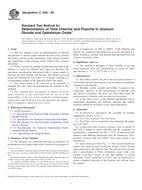Potrebujeme váš súhlas na využitie jednotlivých dát, aby sa vám okrem iného mohli ukazovať informácie týkajúce sa vašich záujmov. Súhlas udelíte kliknutím na tlačidlo „OK“.
ASTM C1458-09e1
Standard Test Method for Nondestructive Assay of Plutonium, Tritium and 241Am by Calorimetric Assay (Includes all amendments And changes 4/5/2016).
Automaticky preložený názov:
Štandardná skúšobná metóda pre nedeštruktívne plutónia, trícium a 241 Am od kolorimetrické testu
NORMA vydaná dňa 1.2.2009
Informácie o norme:
Označenie normy: ASTM C1458-09e1
Poznámka: NEPLATNÁ
Dátum vydania normy: 1.2.2009
Kód tovaru: NS-11367
Počet strán: 12
Približná hmotnosť: 36 g (0.08 libier)
Krajina: Americká technická norma
Kategória: Technické normy ASTM
Kategórie - podobné normy:
Anotácia textu normy ASTM C1458-09e1 :
Keywords:
Atmospheric analysis, Calorimeter, Nondestructive evaluation (NDE)--nuclear applications, Plutonium, Tritium, ICS Number Code 27.120.30 (Fissile materials and nuclear fuel technology)
Doplňujúce informácie
| Significance and Use | ||||||||||||
|
This test method is the most accurate NDA technique for the assay of many physical forms of Pu. Isotopic measurements by gamma-ray spectroscopy or destructive analysis techniques are part of the test method when it is applied to the assay of Pu. Calorimetry has been applied to a wide variety of Pu-bearing solids including metals, alloys, oxides, fluorides, mixed Pu-U oxides, mixed oxide fuel pins, waste, and scrap, for example, ash, ash heels, salts, crucibles, and graphite scarfings) (2,3). This test method has been routinely used at U.S. and European facilities for Pu process measurements and nuclear material accountability for the last 40 years (2-9). Pu-bearing materials have been measured in calorimeter containers ranging in size from about 0.025 m to about 0.60 m in diameter and from about 0.076 m to about 0.9 m in height. Gamma-ray spectroscopy typically is used to determine the Pu-relative isotopic composition and 241Am to Pu ratio (see Test Method C 1030). Isotopic information from mass spectrometry and alpha counting measurements may be used (see Test Method C 697). This test method is the most accurate NDA method for the measurement of tritium. For many physical forms of tritium compounds calorimetry is the only practical measurement technique available. Physical standards representative of the materials being assayed are not required for the test method. This test method is largely independent of the elemental distribution of the nuclear materials in the matrix. The accuracy of the method can be degraded for materials with inhomogeneous isotopic composition. The thermal power measurement is traceable to national measurement systems through electrical standards used to directly calibrate the calorimeters or to calibrate secondary 238Pu heat standards. Heat-flow calorimetry has been used to prepare secondary standards for neutron and gamma-ray assay systems (7-12). Calorimetry measurement times are typically longer than other NDA techniques. Four parameters of the item and the item packaging affect measurement time. These four parameters are density, mass, thermal conductivity, and change in temperature. The measurement well of passive calorimeters will also affect measurement time because it too will need to come to the new equilibrium temperature. Calorimeters operated in servo mode maintain a constant measurement well temperature and have no effect on measurement time. Calorimeter measurement times range from 20 minutes (13) for smaller, temperature-conditioned, containers up to 24 h for larger containers and items with long thermal-time constants. Measurement times may be reduced by using equilibrium prediction techniques, by temperature preconditioning of the item to be measured, or operating the calorimeter using the servo-control technique. |
||||||||||||
| 1. Scope | ||||||||||||
|
1.1 This test method describes the nondestructive assay (NDA) of plutonium, tritium, and 241Am using heat flow calorimetry. For plutonium the typical range of applicability corresponds to ~1 g to ~2000 g quantities while for tritium the typical range extends from ~0.001 g to~ 10 g. This test method can be applied to materials in a wide range of container sizes up to 50 L. It has been used routinely to assay items whose thermal power ranges from 0.001 W to 135 W. 1.2 This test method requires knowledge of the relative abundances of the plutonium isotopes and the 241Am/Pu mass ratio to determine the total plutonium mass. 1.3 This test method provides a direct measure of tritium content. 1.4 This test method provides a measure of 241Am either as a single isotope or mixed with plutonium. 1.5 The values stated in SI units are to be regarded as standard. No other units of measurement are included in this standard. 1.6 This standard does not purport to address all of the safety concerns, if any, associated with its use. It is the responsibility of the user of this standard to establish appropriate safety and health practices and determine the applicability of regulatory limitations prior to use. |
||||||||||||
| 2. Referenced Documents | ||||||||||||
|
Podobné normy:
Historická
1.1.2014
Historická
1.1.2014
Historická
1.2.2009
Historická
1.6.2009
Historická
1.6.2009
Historická
1.1.2008
Odporúčame:
Aktualizácia technických noriem
Chcete mať istotu, že používate len platné technické normy?
Ponúkame Vám riešenie, ktoré Vám zaistí mesačný prehľad o aktuálnosti noriem, ktoré používate.
Chcete vedieť viac informácií ? Pozrite sa na túto stránku.



 ASTM C1477-08(2014)..
ASTM C1477-08(2014).. ASTM C1490-14
ASTM C1490-14 ASTM C1493-09
ASTM C1493-09 ASTM C1502-09
ASTM C1502-09 ASTM C1517-09
ASTM C1517-09 ASTM C1553-08
ASTM C1553-08
 Cookies
Cookies
